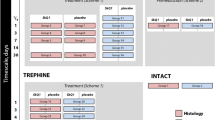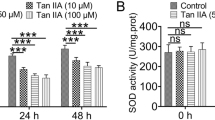Abstract
Diseases of the cornea are a frequent cause of blindness worldwide. Keratoplasty is an efficient method for treating severely damaged cornea. The functional competence of corneal endothelial cells is crucial for successful grafting, which requires improving the media for the hypothermic cornea preservation, as well as developing the methods for the evaluation of the corneal functional properties. The transport of water and ions by the corneal endothelium is important for the viability and optic properties of the cornea. We studied the impact of SkQ1 on the equilibrium sodium concentration in the endothelial cells after hypothermic preservation of pig cornea at 4C for 1, 5, and 10 days in standard Eusol-C solution. The intracellular sodium concentration in the endothelial cells was assayed using the fluorescent dye Sodium Green; the images were analyzed with the custom-designed CytoDynamics computer program. The concentrations of sodium in the pig corneal endothelium significantly increased after 10 days of hypothermic preservation, while addition of 1.0 nM SkQ1 to the preservation medium decreased the equilibrium concentration of intracellular sodium (at 37C). After 10 days of hypothermic preservation, the permeability of the plasma membrane for sodium decreased in the control cells, but not in the cells preserved in the presence of 1 nM SkQ1. Therefore, SkQ1 increased the ability of endothelial cells to restore the intracellular sodium concentration, which makes SkQ1 a promising agent for facilitating retention of the functional competence of endothelial cells during cold preservation.




Similar content being viewed by others
Abbreviations
- AOI:
-
area of interest
- [Na+]I :
-
intracellular sodium ion concentration
- SkQ1:
-
10-(6′-plastoquinonyl) decyltriphenylphosphonium
References
Maghsoudlou, P., Sood, G., and Akhondi, H. (2020) Cornea transplantation, in StatPearls [Internet], StatPearlsPublishing, Treasure Island (FL).
Bourne, W. M. (1998) Clinical estimation of corneal endothelial pump function, Trans. Am. Ophthalmol. Soc., 96, 229-239.
Riley, M. V., Winkler, B. S., and Starnes, C. A. (1998) Regulation of corneal endothelial barrier function by adenosine, cyclic AMP, and protein kinases, Invest. Ophthalmol. Vis. Sci., 39, 2076.
Bonanno, J. A. (2012) Molecular mechanisms underlying the corneal endothelial pump, Exp. Eye Res., 95, 2-7, https://doi.org/10.1016/j.exer.2011.06.004.
Schmedt, T., Silva, M. M., Ziaei, A., and Jurkunas, U. (2012) Molecular bases of corneal endothelial dystrophies, Exp. Eye Res., 95, 24-34, https://doi.org/10.1016/j.exer.2011.08.002.
Kuang, K., Li, Y., Yiming, M., Sánchez, J. M., Iserovich, P., et al. (2004) Intracellular [Na+], Na+ pathways, and fluid transport in cultured bovine corneal endothelial cells, Exp. Eye. Res., 79, 93-103, https://doi.org/10.1016/j.exer.2004.02.014.
Riley, M., Winkler, B., Czajkowski, C., and Peters, M. (1995) The roles of bicarbonate and CO2 in transendothelial fluid movement and control of corneal thickness, Invest. Ophthalmol. Vis. Sci., 36, 103-112.
Bonanno, J. A. (2003) Identity and regulation of ion transport mechanisms in the corneal endothelium, Prog. Retin Eye Res., 22, 69-94, https://doi.org/10.1016/s1350-9462(02)00059-9.
Bonanno, J. A., Guan, Y., Jelamskii, S., and Kang, X. J. (1999) Apical and basolateral CO2-HCO3- permeability in cultured bovine corneal endothelial cells, Am. J. Physiol., 277, C545-C553, https://doi.org/10.1152/ajpcell.1999.277.3.C545.
Baturina, G. S., Pal’chikova, I. G., Konev, A. A., Smirnov, E. S., Katkova, L. E., et al. (2018) Examining effects of hypothermic conservation on sodium level in corneal graft endothelial cells [in Russian], Vavilovskiy Zhurnal Genetiki i Selektsii, 22, 433-437, https://doi.org/10.18699/VJ18.379.
Baturina, G. S., Katkova, L. E., Pal’chikova, I. G., Solenov, E. I., and Iskakov, I. A. (2019) New approaches to examining functional activity of endothelial cells in corneal preparations [in Russian], Sovremennye Tekhnologii v Oftal'mologii, 5, 262-265, https://doi.org/10.25276/2312-4911-2019-5-262-265.
Wei, Y., Troger, A., Spahiu, V., Perekhvatova, N., et al. (2019) The role of SKQ1 (Visomitin) in inflammation and wound healing of the ocular surface, Ophthalmol. Ther., 8, 63-73, https://doi.org/10.1007/s40123-018-0158-2.
Brzheskiy, V. V., Efimova, E. L., Vorontsova, T. N., Alekseev, V. N., gusarevich, O. G., et al. (2015) Results of a multicenter, randomized, double-masked, placebo-controlled clinical study of the efficacy and safety of Visomitin eye drops in patients with dry eye syndrome, Adv. Ther., 32, 1263-1279, https://doi.org/10.1007/s12325-015-0273-6.
Silachev, D. N., Plotnikov, E. Y., Pevzner, I. B., Zorova, L. D., Balakireva, A. V., et al. (2018) Neuroprotective effects of mitochondria-targeted plastoquinone in a rat model of neonatal hypoxic-ischemic brain injury, Molecules, 23, 1871, https://doi.org/10.3390/molecules23081871.
Solenov, E. I. (2008) Cell volume and sodium content in rat kidney collecting duct principal cells during hypotonic shock, J. Biophys., 2008, 420963, https://doi.org/10.1155/2008/420963.
Ilyaskin, A. V., Karpov, D. I., Medvedev, D. A., Ershov, A. P., Baturina, G. S., et al. (2014) Quantitative estimation of transmembrane ion transport in rat renal collecting duct principal cells, Gen. Physiol. Biophys., 33, 13-28, https://doi.org/10.4149/gpb_2013063.
Ilyackin, A. V., Batupina, G. C., Medvedev, D. A., Epshov, A. P., Colenov, E. I. (2011) Examining reaction of renal collecting duct main cells to hypotonic shock. Experiment and mathematical modeling [in Russian], Biofizika, 56, 550-560, https://doi.org/10.1134/S0006350911030092.
Palchikova, I. G., Smirnov, E. S., and Konev, A. A. (2017) Analyses of DNA image cytometry uncertainty caused by diffractive blurring, Appl. Mech. Mater., 870, 369-374, https://doi.org/10.4028/www.scientific.net/AMM.870.369.
Winslow, J. L., Cooper, R. L., and Atwood, H. L. (2002) Intracellular ionic concentration by calibration from fluorescence indicator emission spectra, its relationship to the K(d), F(min), F(max) formula, and use with Na-Green for presynaptic sodium, J. Neurosci. Methods., 118, 163-175, https://doi.org/10.1016/s0165-0270(02)00100-0.
Maycock, N. J., and Marshall, J. (2014) Genomics of corneal wound healing: a review of the literature, Acta Ophthalmol., 92, e170-e184, https://doi.org/10.1111/aos.12227.
Edelhauser, H. F. (2000) The resiliency of the corneal endothelium to refractive and intraocular surgery, Cornea, 19, 263–273, https://doi.org/10.1097/00003226-200005000-00002.
Joyce, N. C. (2003) Proliferative capacity of the corneal endothelium, Prog. Retin. Eye Res., 22, 359-389, https://doi.org/10.1016/s1350-9462(02)00065-4.
Vianna, L. M., Li, H. D., Holiman, J. D., Stoeger, C., Belfort, R. Jr., and Jun, A. S. (2016) Characterization of cryopreserved primary human corneal endothelial cells cultured in human serum-supplemented media, Arq. Bras. Oftalmol., 79, 37-41, https://doi.org/10.5935/0004-2749.20160011.
Ptushenko, V. V., Solovchenko, A. E., Bychkov, A. Y., Chivkunova, O. B., Golovin, A. V., et al. (2019) Cationic penetrating antioxidants switch off Mn cluster of photosystem II in situ, Photosynth. Res., 142, 229-240, https://doi.org/10.1007/s11120-019-00657-2.
Rokitskaya, T. I., Murphy, M. P., Skulachev, V. P., and Antonenko, Y. N. (2016) Ubiquinol and plastoquinol triphenylphosphonium conjugates can carry electrons through phospholipid membranes, Bioelectrochemistry, 111, 23-30, https://doi.org/10.1016/j.bioelechem.2016.04.009.
Antonenko, Y. N., Avetisyan, A. V., Bakeeva, L. E., Chernyak, B. V., Chertkov, V. A., et al. (2008) Mitochondria-targeted plastoquinone derivatives as tools to interrupt execution of the aging program. 1. Cationic plastoquinone derivatives: synthesis and in vitro studies, Biochemistry (Moscow), 73, 1273-1287, https://doi.org/10.1134/s0006297908120018.
Saretzki, G., Murphy, M. P., and von Zglinicki, T. (2003) MitoQ counteracts telomere shortening and elongateslifespan of fibroblasts under mild oxidative stress, Aging Cell, 2, 141-143, https://doi.org/10.1046/j.1474-9728.2003.00040.x.
Funding
This study was supported by the Russian Foundation for Basic Research (projects nos. 19-08-00874 and 20-015-00147-a) and State Assignment (project no. 0259-2021-0016).
Author information
Authors and Affiliations
Corresponding author
Ethics declarations
The authors declare no conflict of interests. All applicable international, nation-wide, and/or institutional guidelines for animal care and use have been followed.
Rights and permissions
About this article
Cite this article
Baturina, G.S., Katkova, L.E., Palchikova, I.G. et al. Mitochondrial Antioxidant SkQ1 Improves Hypothermic Preservation of the Cornea. Biochemistry Moscow 86, 382–388 (2021). https://doi.org/10.1134/S0006297921030135
Received:
Revised:
Accepted:
Published:
Issue Date:
DOI: https://doi.org/10.1134/S0006297921030135




